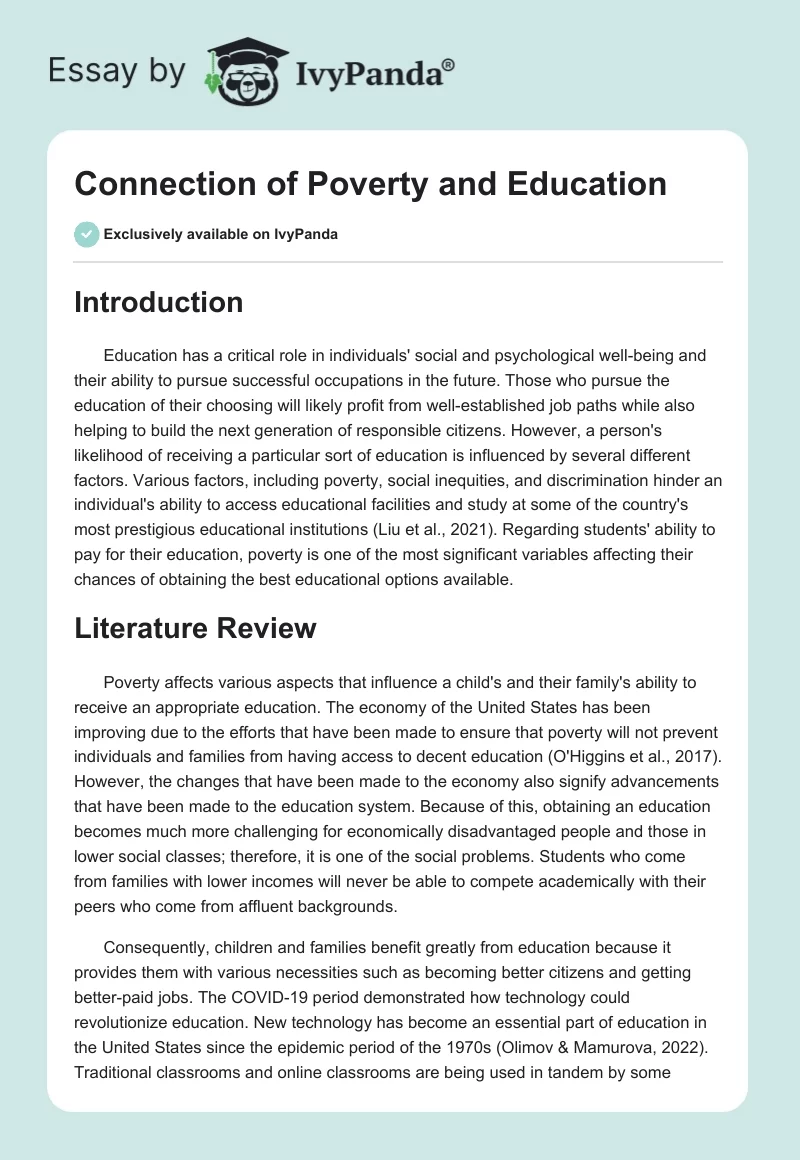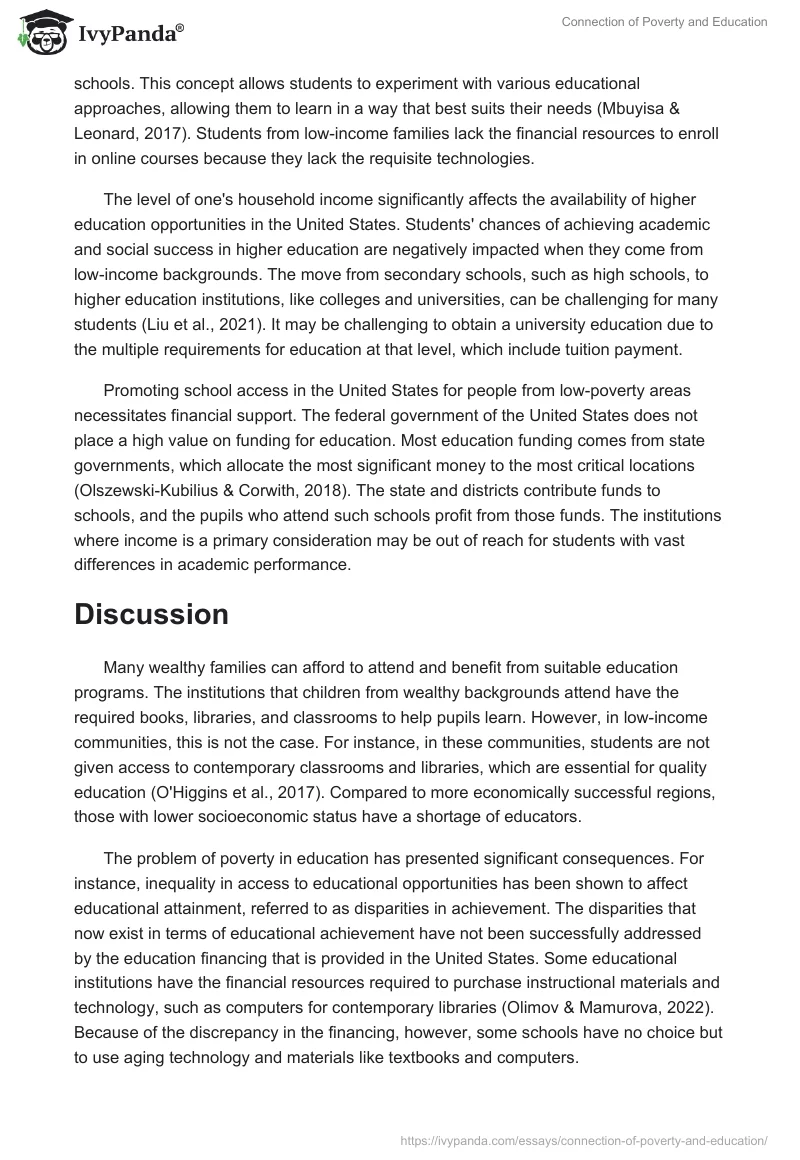Introduction
Education has a critical role in individuals’ social and psychological well-being and their ability to pursue successful occupations in the future. Those who pursue the education of their choosing will likely profit from well-established job paths while also helping to build the next generation of responsible citizens. However, a person’s likelihood of receiving a particular sort of education is influenced by several different factors. Various factors, including poverty, social inequities, and discrimination hinder an individual’s ability to access educational facilities and study at some of the country’s most prestigious educational institutions (Liu et al., 2021). Regarding students’ ability to pay for their education, poverty is one of the most significant variables affecting their chances of obtaining the best educational options available.
Literature Review
Poverty affects various aspects that influence a child’s and their family’s ability to receive an appropriate education. The economy of the United States has been improving due to the efforts that have been made to ensure that poverty will not prevent individuals and families from having access to decent education (O’Higgins et al., 2017). However, the changes that have been made to the economy also signify advancements that have been made to the education system. Because of this, obtaining an education becomes much more challenging for economically disadvantaged people and those in lower social classes; therefore, it is one of the social problems. Students who come from families with lower incomes will never be able to compete academically with their peers who come from affluent backgrounds.
Consequently, children and families benefit greatly from education because it provides them with various necessities such as becoming better citizens and getting better-paid jobs. The COVID-19 period demonstrated how technology could revolutionize education. New technology has become an essential part of education in the United States since the epidemic period of the 1970s (Olimov & Mamurova, 2022). Traditional classrooms and online classrooms are being used in tandem by some schools. This concept allows students to experiment with various educational approaches, allowing them to learn in a way that best suits their needs (Mbuyisa & Leonard, 2017). Students from low-income families lack the financial resources to enroll in online courses because they lack the requisite technologies.
The level of one’s household income significantly affects the availability of higher education opportunities in the United States. Students’ chances of achieving academic and social success in higher education are negatively impacted when they come from low-income backgrounds. The move from secondary schools, such as high schools, to higher education institutions, like colleges and universities, can be challenging for many students (Liu et al., 2021). It may be challenging to obtain a university education due to the multiple requirements for education at that level, which include tuition payment.
Promoting school access in the United States for people from low-poverty areas necessitates financial support. The federal government of the United States does not place a high value on funding for education. Most education funding comes from state governments, which allocate the most significant money to the most critical locations (Olszewski-Kubilius & Corwith, 2018). The state and districts contribute funds to schools, and the pupils who attend such schools profit from those funds. The institutions where income is a primary consideration may be out of reach for students with vast differences in academic performance.
Discussion
Many wealthy families can afford to attend and benefit from suitable education programs. The institutions that children from wealthy backgrounds attend have the required books, libraries, and classrooms to help pupils learn. However, in low-income communities, this is not the case. For instance, in these communities, students are not given access to contemporary classrooms and libraries, which are essential for quality education (O’Higgins et al., 2017). Compared to more economically successful regions, those with lower socioeconomic status have a shortage of educators.
The problem of poverty in education has presented significant consequences. For instance, inequality in access to educational opportunities has been shown to affect educational attainment, referred to as disparities in achievement. The disparities that now exist in terms of educational achievement have not been successfully addressed by the education financing that is provided in the United States. Some educational institutions have the financial resources required to purchase instructional materials and technology, such as computers for contemporary libraries (Olimov & Mamurova, 2022). Because of the discrepancy in the financing, however, some schools have no choice but to use aging technology and materials like textbooks and computers.
It is of the utmost importance to address the inequalities in school funding to make it possible for students who are enrolled in low-income areas to obtain the same level of education as their peers who are enrolled in high-class schools. There are disparities in the funding provided to public schools, making it difficult for pupils to pursue the subjects of their choosing (Olszewski-Kubilius & Corwith, 2018). Low achievement in high school can restrict the colleges and universities where students can continue their education after high school.
Intervention and Solutions
The important question in this sub-topic is; what are the solutions to the problem? For instance, there is a need for significant changes to how money is allocated to guarantee that every person has the opportunity they require to achieve their goals in life and become successful. Some higher education institutions have more teachers and educators available than they need, while other regions suffer from a teacher and educator shortage. The imbalances resulting from the United States’ funding practices should be the primary focus of public policy (Olszewski-Kubilius & Corwith, 2018). In addition, the federal government’s participation must be enhanced to guarantee that all people may obtain the appropriate level of education.
The gap in educational attainment between the rich and poor is widening, and early intervention is needed to close it. People in low-income areas will likely continue to face hardships as the attainment gap between them and those in higher-income areas widens. Students who live in low-income neighborhoods may have a more challenging time achieving good academic standards. The ability of a child to learn and concentrate in school is likely to be negatively impacted by poverty and the difficulties it brings to the family (Olszewski-Kubiliu & Corwith, 2018). While students from wealthy households attend schools equipped with all the latest technology, their academic performance remains a big issue.
Conclusion
In the United States, education plays a significant role in achieving opportunities. The United States believes that education is one of the most effective ways to combat the country’s persistent poverty. On the other hand, poverty is a significant barrier to obtaining educational opportunities. As a result of their low socioeconomic status, low-income students are more likely to attend low-quality schools and educational institutions. Schools in poverty-stricken areas cannot provide a conducive environment for students to excel academically.
The government’s initiatives to increase education financing should reduce educational attainment gaps. Classrooms in low-income regions should be equipped with all the materials and technology pupils need to succeed academically, and this is something the federal government can help with. There is still a need for teachers to work in low-income regions, which is also an issue. Even while the government emphasizes the importance of education in the fight against poverty, those living in low-income areas have a tough time gaining access to the training they need to find work and establish the careers they envision for themselves.
References
Liu, F., Li, L., Zhang, Y., Ngo, Q. T., & Iqbal, W. (2021). Role of education in poverty reduction: macroeconomic and social determinants form developing economies. Environmental Science and Pollution Research, 28(44), 63163-63177.
Mbuyisa, B., & Leonard, A. (2017). The role of ICT use in SMEs towards poverty reduction: A systematic literature review. Journal of International Development, 29(2), 159-197.
O’Higgins, A., Sebba, J., & Gardner, F. (2017). What are the factors associated with educational achievement for children in kinship or foster care: A systematic review. Children and Youth Services Review, 79, 198-220.
Olimov, S. S., & Mamurova, D. I. (2022). Information Technology in Education. Pioneer: Journal of Advanced Research and Scientific Progress, 1(1), 17-22.
Olszewski-Kubilius, P., & Corwith, S. (2018). Poverty, academic achievement, and giftedness: A literature review. Gifted Child Quarterly, 62(1), 37-55.


